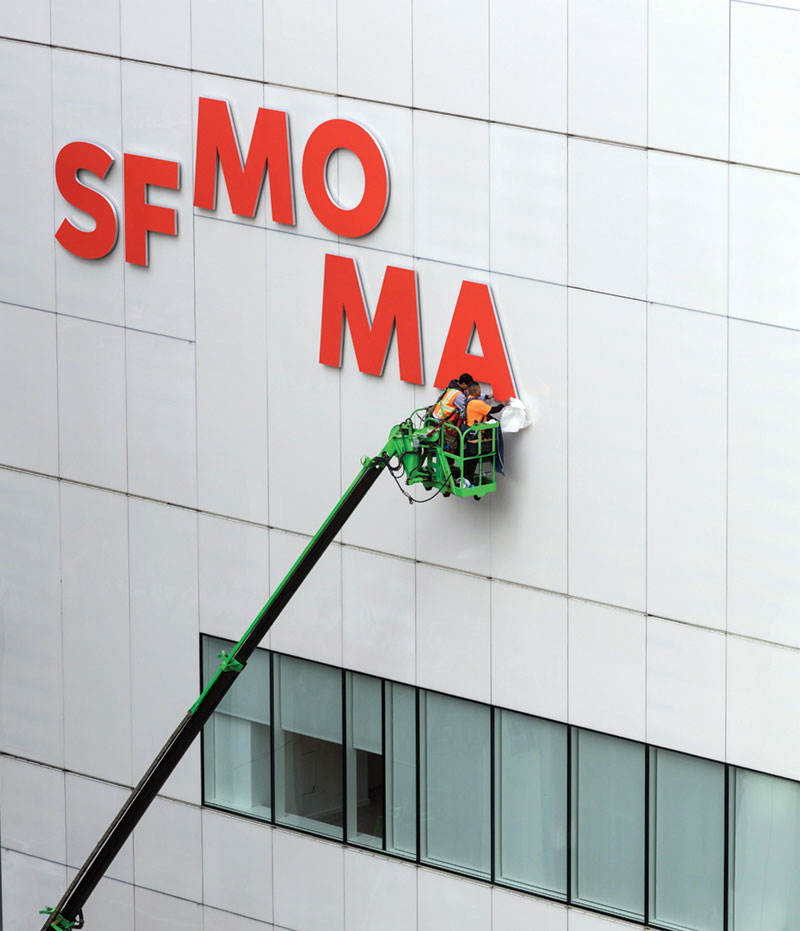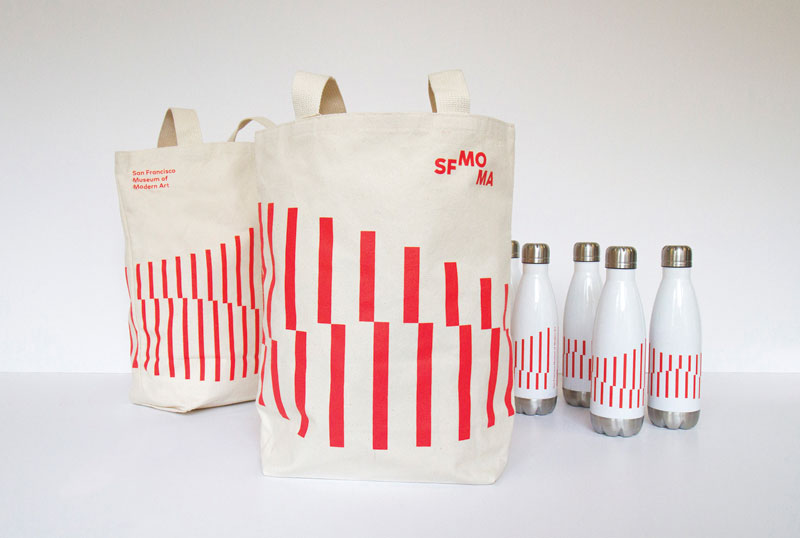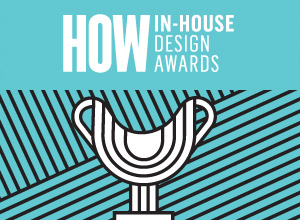When the San Francisco Museum of Modern Art (SFMOMA) began planning an expansion of the institution in 2013, the museum’s leadership made the unusual decision that the in-house creative team—instead of an external design agency—would create an identity to be implemented in tandem with the new construction.
“Museums often turn to prominent outside firms for the creation of a new identity as a way of buying talent, prestige and the promise of gaining new insights from experts in the field,” says Jennifer Sonderby, design director and leader of the SFMOMA Design Studio. “The leadership of SFMOMA instead decided that it made sense for our team—who already shared the values of the organization and had been living and breathing the identity every day—to create the identity that we would then grow and nurture long after its inception.”
So the seven-person Design Studio embarked on an ambitious three-year project that involved overhauling the entire SFMOMA visual identity, including the logo, color palette, typeface (with help from FontShop), wayfinding icons and graphic pattern. These elements were then translated into a new website, online magazine, building identification and signage (with help from SOM Graphics), events décor, invitations, business cards, store products, brochures and more. You name it, they designed it.
The objective of the project was to develop a new identity for the institution that not only reflected a transformation of the museum’s physical space, but also embodied its thinking and approaches. In particular, it was designed in response to seven experience principles of the museum: Welcoming, Surprising, Participatory, For Our Time, Boundaryless, Illuminating and Open.
“The final outcome visually illustrates our institutional values and the experience of the physical museum—visually opening up just as the building now does to the city, and welcoming visitors to a wide variety of experiences,” Sonderby says. “The most fulfilling part of the project was the intensely tight collaboration that it required and how our team rose to the occasion, pouring ourselves into it. The final outcome was reflective of the energy and passion of the six staff members on the project.”

Design-Driven
That level of energy and passion could only be sustained for a three-year-long project by a team that truly believes in the transformative power of art.
While SFMOMA was founded in 1935, the museum’s in-house design team was only assembled in 1987. Originally a two-person operation, it was nested within the Publications, Web and Graphic Design department. In 2013—the same year the redesign project began—the Design Studio was incorporated into the Content Strategy and Digital Engagement Division, which also includes Interpretive Media, Publications, Community Engagement and Web+Digital.
“In contrast to many other museums, this division is considered a programmatic strand of the museum, and works collaboratively with colleagues in Marketing and Communications over in the External Affairs area,” Sonderby says. She adds that the passion, dedication and care that each staff member commits to the museum’s endeavors, down to the last detail, makes the SFMOMA Design Studio’s culture unique. “Every day provides an opportunity to learn—from a colleague, an artist or an exhibition. Passion is the special sauce that creates the SFMOMA magic.”
As part of an institution that routinely showcases the best in contemporary design, the team took enormous pride in the idea that they had the creative chops to craft an exceptionally beautiful and flexible identity themselves. But even with the three-year timeline that included a break from designing exhibits while the museum was temporarily closed, Sonderby says the biggest challenge, given the huge scope of the project, was redesigning every brand touchpoint in time
for opening. That opening happened in May 2016.
Similar to the architectural features of its expansion, the new visual identity is designed to be porous, open and welcoming, providing multiple points of access. Both the building and the brand were inspired by the surrounding hills and the water and fog of the
San Francisco Bay.
The refresh generated excitement not only among Bay-area residents and tourists, but also the HOW In-House Design Awards judges who bestowed the project with Best of Show. Judge Shani Sandy, executive creative director at S&P Global, explains what compelled her to make that designation: “The SFMOMA new visual identity is simply exciting. The identity is reinterpreted continuously across various applications that encounter it, and it greets these mediums in a way that remains pure to its origin, but feels fresh each time. The undeniable spark the warm red signature color gives to the system is invigorating, particularly when punctured by the unexpected and dynamic plays of type, scale and illustrative lines. The identity epitomizes modernity from the custom typeface, color and layout. It’s new to the eye each and every time.”
Moving On Up
A new building for the museum also meant new digs for the Design Studio. “Our workspace is on the top floor of the new building, 10 tall stories above the city, about a 45-second elevator ride if no one else gets in,” Sonderby says. “From our windows, we can see the Bay Bridge, Transamerica building, and the occasional drone flying by (origins unknown).”
The office is an open space environment that stands in sharp contrast to the textured, grey, full-height cubes the team had inhabited for the prior decade in an annex across the street from the museum. Like the galleries, everything is white: the desks, the cubes and the walls. And as with any new home, there are mostly pros, but a few drawbacks. For example: “We have an amazing, glass-enclosed gathering place at the end of our floor connected to an outside deck; both provide expansive views east and west—a new perspective of the city and bay that is truly inspiring,” Sonderby says. “The downside: All the windows mean that we continually struggle to find enough wall space to display and critique our team’s work.”
One of the biggest benefits is that the team is now housed within the actual museum walls, which helps keep them creative and inspired. “The Design Studio spends lots of time in the galleries, surrounded by objects created by the most inspiring thinkers and makers of our time,” Sonderby says. “We laugh a lot together and occasionally decide that we should sing our ideas to the group rather than just describing them. Surprisingly, our cube neighbors don’t appreciate this.” In that same vein, the Design Team’s workspaces are organized rather unconventionally—according to the volume of noise they create, loudest to quietest, moving east to west.

Canteens and totes using the new SFMOMA graphic pattern
Forward-Thinking
So what’s next for this award-winning team that’s not afraid of a challenge? “There is an upcoming sound-based exhibition that will inhabit several floors in the museum—none of which are typical exhibition spaces,” Sonderby says. “The exhibit will provide an opportunity for our team to consider the potential for creative wayfinding possibilities that we have not
yet explored.”
And of course, a rebrand is never really finished. “In a sense, the work has just begun,” Sonderby says. “We now need to devote ourselves to the nurture and growth of our new identity, continually evolving it in response to our ever-changing program, our deeper understanding of how the new building works, and the emerging technology platforms adopted by the museum.”
For just a moment, though, the team should take time to celebrate and bask in the glow of praise from the design community. In the words of HOW judge Vanessa Dewey, Art Director at Mattel: “I can’t say enough of this rebrand. Without diving too far into details of what makes this a brilliant rebrand, the SFMOMA team has created an elegant, yet bold, rebrand that celebrates all the newness of the SFMOMA and its home of SF. I simply love it.”
CREATIVE TEAM Amy Yu Gray, Bosco Hernandez, Sophine Lim, James Provenza, Jennifer Sonderby, Mathieu Stemmelen
(Related: All Winners of the 2016 In-House Design Awards)
In-House Design Teams: Your Deadline is July 5, 2017!
 HOW’s In-House Design Awards recognizes the best creative work produced by designers doing in-house work for corporations, associations and organizations. From corporate identity, sales collateral, point-of-purchase displays, employee communication, membership materials and more, this premiere awards program shines a spotlight on an under-represented segment of the design industry. Submissions are evaluated by business category to ensure that a broad range of design work is represented
HOW’s In-House Design Awards recognizes the best creative work produced by designers doing in-house work for corporations, associations and organizations. From corporate identity, sales collateral, point-of-purchase displays, employee communication, membership materials and more, this premiere awards program shines a spotlight on an under-represented segment of the design industry. Submissions are evaluated by business category to ensure that a broad range of design work is represented
See your team’s work in the Winter 2017 issue of HOW magazine. Enter today!







